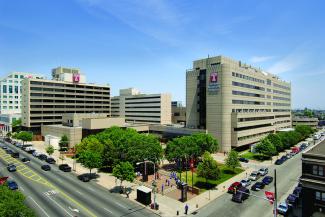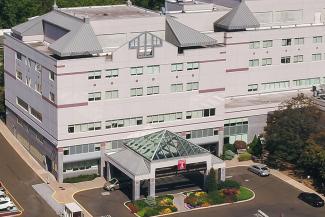A thoracoabdominal aortic aneurysm is a bulging, weakened area in the wall of the aorta where it descends from the chest to the abdomen. It’s a serious condition that often goes undetected, but when it appears, our vascular specialists are skilled at repairing the body’s largest blood vessel. Temple’s Thoracoabdominal Aortic Aneurysm Program helps patients understand and manage this condition to avoid life-threatening complications.
Identifying a Hidden Danger
The aorta channels all of the blood from the heart to the rest of the body, and the high pressure to which it is subject can cause a weakened area in the vessel wall to bulge outwards. After a time, this thinned area may rupture, leading to internal bleeding. Often, the initial weakness is caused by the buildup of arterial plaque that stiffens and weakens the aortic wall.
Most thoracoabdominal aortic aneurysms are diagnosed by chance since there are rarely symptoms, but our team is available to consult with patients who, because of family history or other factors, are worried about their risk or wish to reduce it. Due to the location, size and pressure of blood running through the aorta, a ruptured thoracoabdominal aortic aneurysm is often fatal, so timely diagnosis and treatment are critical to survival. Temple’s specialists use sophisticated imaging technology and minimally invasive diagnostic procedures to pinpoint the location and extent of an aneurysm. Advanced procedures such as angiography can be performed in our comprehensive endovascular labs at the hospital.
Reducing Risk & Repairing Damage
Medication and lifestyle changes can reduce the chance of a small aneurysm becoming more dangerous over time. For larger thoracoabdominal aortic aneurysms, or those at risk of rupture, Temple’s cardiovascular specialists can implant a strong mesh tube (a stent) that supports the wall of the aorta and relieves pressure on the aneurysm. This is often a minimally invasive procedure performed through a flexible tube called a catheter. Alternatively, specialized “hybrid” surgical facilities at Temple University Hospital may allow us to perform aortic stenting in combination with another scheduled procedure like bypass surgery. If the aneurysm is very large, the damaged section of the aorta may be surgically repaired or replaced with a strong synthetic tube called a graft. Our vascular surgeons are highly experienced at performing both open and endovascular (catheter-based) aortic repairs.
Skilled & Supportive Care
Temple’s vascular and cardiovascular surgeons and other multidisciplinary specialists work to provide an integrated and compassionate treatment experience for patients, helping them every step of the way to reduce their worry and risk.
Risk Factors
Your chances of having or developing thoracoabdominal aortic aneurysm are higher if you:
- Man and over 60 years of age
- Family history of thoracoabdominal aortic aneurysm
- High cholesterol
- High blood pressure
- Diabetes
- Smoking

